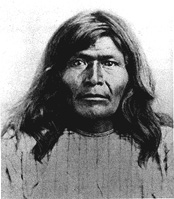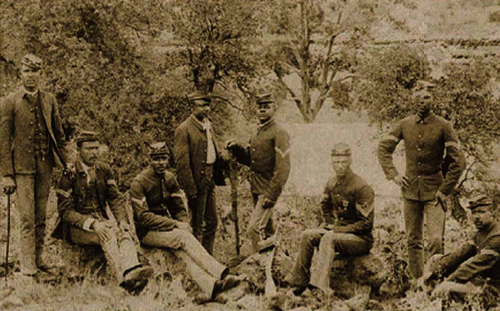Jim Crow Museum
1010 Campus Drive
Big Rapids, MI 49307
[email protected]
(231) 591-5873
I have heard that the Buffalo Soldiers and the Native Americans out west had quite a few battles back in the day.
-- Warren, Gibson, Michigan
Bellow is a list of encounters between the Texas Buffalo Soldiers and Chief Victorio in the late 1800's. Article used with permission from Stanford L. Davis of buffalosoldiers.net.

Background Event: Chief Victorio also known as Apache Wolf, is considered one of the fiercest of the Apache. He and his Warm Springs Apaches left the hated San Carlos Reservation. He had done this twice before, but had returned. When moved to Fort Stanton, New Mexico he fled again, but this time he said, he would never return. Victorio reasoned that the arrival of the new judge and district attorney meant he would be tried for old murders and horse stealing. He and others also left, because government would not give them their promised food allotments, so they and their families were starving. Before Victorio's breakout, the heroic Ninth U.S. Cavalry had been given the distasteful task of returning Apaches who left their reservation. They also had to protect the Apaches on and off the reservation from cowboys and others who often hunted and killed Indians for sport. Some whites made a living by selling Indian scalps to the Mexican government who paid $50 for a male, $25 for a female and $10 for a child's scalp. At one time, the Apaches had been allowed to hunt under the protection of the military, but the settlers didn't like seeing armed Indians so the practice was discontinued. Colonel Hatch of the Ninth U.S. Cavalry, complained to General Sheridan that the Apaches were going to starve if they couldn't leave the reservation to hunt. Sheridan was not impressed with Hatch's letter.
September 4, 1879: Ojo Caliente, Arizona; As Victorio became more and more hate filled, he began to mutilate bodies. Soon after breaking out of the San Carlos Reservation, Victorio and the men struck at Captain Hooker and Company E of the Ninth stealing forty-six of their horses. In the aftermath, five Buffalo Soldiers lay dead with their bodies staked to the ground. They were Sergeant Silas Chapman, Privates Lafayerre Hoke, William Murphy, Silas Graddon and Alvrew Percival. Victorio and his band escaped.
September 10, 1879: By this time, nine settlers had been killed by Victorio's band and other groups of Apaches had joined in the fighting. All of the Ninth's Companies with Apache and Navaho scouts were in the field, always one step behind Victorio. Thousands of soldiers would continue this scenario for the next year, skirmishing Victorios' band over thousands of grueling miles, in the worst of conditions.
September 16, Black Range Mountains, New Mexico: Lieutenant Colonel Dudley with Captain Dawson's B Company and Hooker's E were ambushed and trapped by Vicrorio's warriors. They were rescued by Captain Beyer and Lieutenant Hugo of Companies C and G. After a day of fighting, the soldiers broke off the engagement. Five soldiers, three scouts and thirty-two horses lay dead after the bloody battle.
November 1879: The Candelaria Mountains, Mexico: Victorio and his warriors ambushed and killed fifteen Mexican citizens from the little village of Carrizal, who were looking for cattle thieves. Later, eleven more citizens were killed while searching for those what had not returned. The Mexican government telegraphed the U.S. commander in the area, to inform him that they were after Victorio, which would probably drive him back into Texas.
January 9-May 1880: Major Morrow, who had assumed command of operations in Southern New Mexico, sent the Buffalo Soldiers of the Ninth against Victorio's band many times during this period. In most of these cases, Victorio's war party fought off the soldiers. Sometimes the fighting ended quickly. At other times, it lasted for long hours.
May 1880: General Sheridan assigned Colonel Grierson's Tenth U.S. Cavalry to assist in the capture of Victorio. Instead of going into New Mexico, Colonel Grierson felt Victorio would come to Texas to raid. Grierson also decided to change his strategy in confronting Victorio. Instead of his men chasing Victorio across the desolate countryside, he would post them at the canyon passes and water holes he thought Victorio would use.
May 12, Bass Canon west of Fort Davis: Eight Mescalero warriors attacked a wagon train killing two settlers and wounding two. Captain Carpenter of the Tenth U.S. Cavalry with Company H pursued them to the Rio Grande. He was convinced they were on their way to join Victorio.
July 1880 Eagle Springs, Texas: Lieutenant Henry Flipper was the first black officer in the U. S. military and the first to graduate from the West Point Military Academy. He was in charge of three troopers who rode 98 miles in twenty-one hours to inform Captain Gillmore that Victorio's advance guard had been spotted. This information was forwarded to Colonel Grierson who thought Victorio and his warriors would head for Eagle Springs. His men marched sixty-eight miles in twenty-four hours to arrive there ahead of Victorio's band. To their disappointment, Victorio had turned northwest, heading for Rattlesnake Springs. That same night, they marched sixty miles more to Rattlesnake Springs.

August 6, 1880, Rattlesnake Springs, Texas: Captain Viele was placed in charge of Companies C and G of the Tenth as they waited for Victorio's approach. At mid-afternoon their long wait was rewarded. Slowly Victorio's warriors advanced unaware of the ambush. Seconds before the signal to fire was given, Victorio sensed the danger and halted his men. The troopers opened fire. The warriors swiftly withdrew out of range. Needing water and believing there were only a few soldiers, Victorio immediately attacked. Carpenter and B and H companies counter attacked, temporarily halting the Indians advance. Meanwhile, a strong unit of Victorio's band struck at the army wagons that were in route to the springs. They were beaten off, and soon rejoined Victorio's contingent. Victorio's warriors repeatedly charged the troopers to reach the water. Finally, in near darkness, one last attempt was made to reach the spring. It failed and Victorio fled with the troopers in furious pursuit. The chase ended without further bloody contact. With Colonel Grierson's strategy in place, all mountain passes and water holes were now covered by the troopers.
August 9th: Victorio's supply camp was discovered. His guards retreated, leaving twenty-five head of cattle, dried beef and pack animals.
August 11, 1880: The Buffalo Soldiers with Captains Carpenter and Nolon found Victorio and his warriors. In the heat of the thunderous chase, the horses in Carpenter's Company gave out, leaving Nolon's troopers to continue the chase. Victorio's warriors crossed the Rio Grande River into Mexico before Nolon's troopers could catch them. Victorio, like many times before, had escaped. Thus ends the "Battle of Rattlesnake Springs". Soon after Victorio's return to Mexico, its government gave the U.S. military, permission to cross into Mexico with the expressed intention of capturing Victorio dead or alive.
October 4, 1880: Ten companies of the Tenth U.S. Cavalry were placed inside Mexico at the Rio Grande to stop Victorio from returning into Texas. The Tenth and Colonel Jaoquin Terraza's Mexican forces located Victorio and his band. Five days later, the Mexican government informed the American forces their presence in Mexico was no longer needed. The Buffalo Soldiers left under protest. Colonel Grierson asked General Sheridan for permission to return to Mexico, permission was denied.
October 14, 1880: Tres Castillos Mountains, Mexico; Colonel Terrazas and his Mexican troops surrounded
Victorio's camp and attacked. Before the morning was over Victorio, sixty warriors
and eighteen women and children lay dead. Sixty-eight women and children were taken
prisoner.
Death road with Victorio, as silently as a shadow, when he and his warriors returned
toMexico. With Victorio's War at an end, the Trans-Pacos area was somewhat at peace.
Colonel Grierson reported that during "Victorio's War", the Tenth U.S. Cavalry lost
three troopers and saw three wounded. He also reported trooper Private Wesley Hardy
as missing in action.
After completing this campaign, the Tenth was transferred to the Department of Arizona. They were engaged once again in a campaign against Apaches, who this time, was under the leadership of Chief Mangus and the Apache Kid. In September 1886 a detachment from the Tenth Cavalry captured Chief Mangus, the last of the warring Apache chiefs on the Arizona frontier.
Background Event: Chief Sitting Bull escapes to Canada. Crazy Horse surrenders, but is later murdered by a guard.